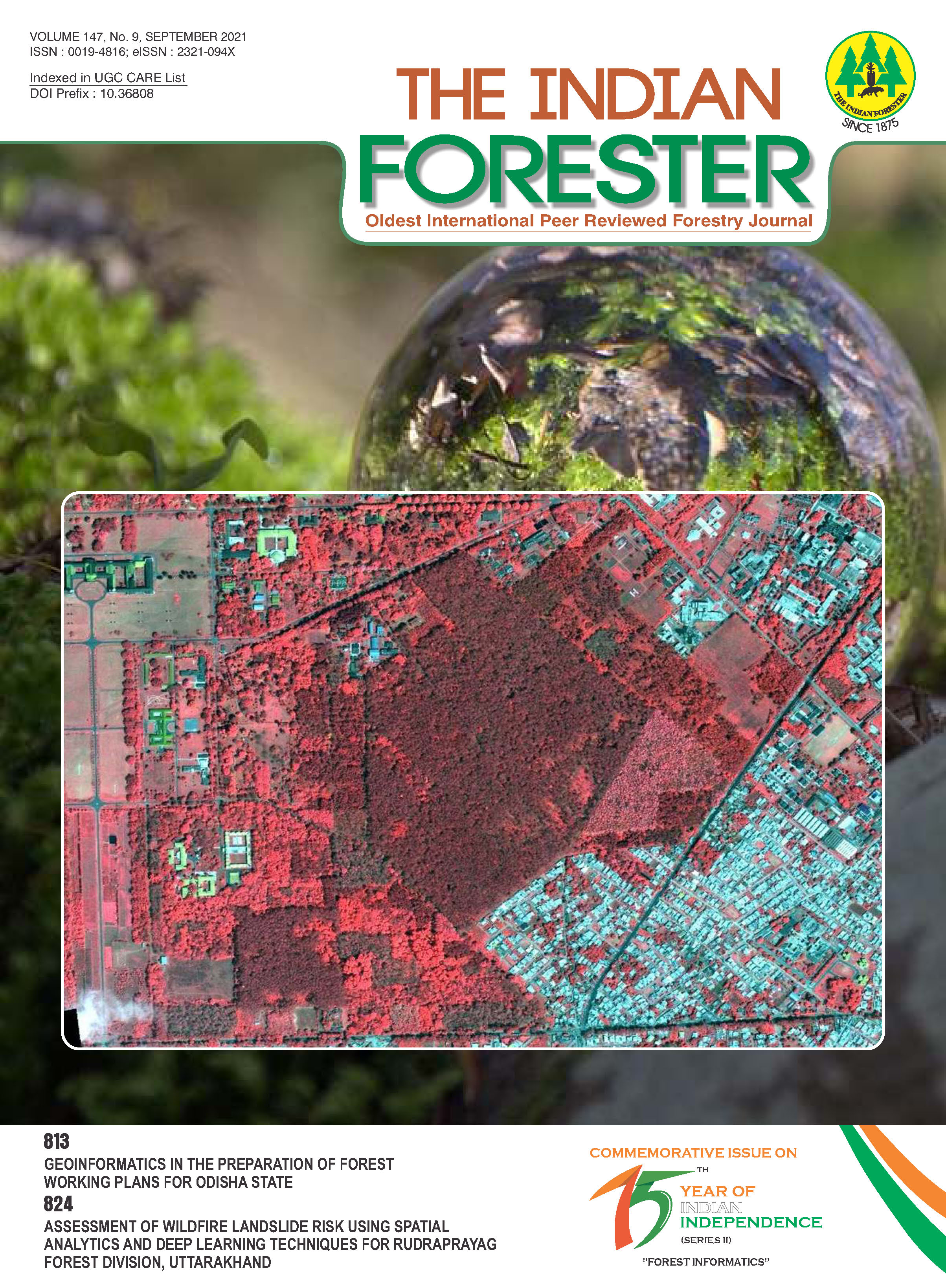Predictive Analysis of Oak Forest Habitat under Different Climatic Change Scenario in Sikkim Himalayas
DOI:
https://doi.org/10.36808/if/2021/v147i9/148022Keywords:
Ecological Niche Modeling, Climate Change, Geospatial Modeling, Oak Forest, Satellite Remote Sensing.Abstract
Sikkim Himalayas are known for its rich biodiversity. Being part of the North eastern Region, which is one of the Biodiversity Hotspots, it is rich in natural resources and supporting a vast variety of flora and faunas. Over a period of time this region has experienced a phenomenal increase in the population; as a result, the rich native tropical evergreen forest has been exploited to a great extent. The Oak forest habitat, which is essentially a part of dense evergreen, and semi evergreen forest are gradually getting open up and exposed to further deterioration. Oak forests habitat, being sensitive to particular climate and physiographic conditions is likely to be affected due to the changing climate scenario. Present study is an attempt to investigate the influence of climate change on Oak forest habitat in Sikkim Himalayas. The current distribution of the Oak forest derived by using satellite remote sensing and field visits and the climate and topographic information has been used to generate climatic envelope of Oak forest habitat. Future scenarios of Oak forest habitat and their potential spatial distribution have been predicted for the year 2050 and 2100 through ecological niche modeling and Geo-spatial techniques.References
Anon. (2002). Biodiversity Characterization at Landscape level at North East India using Satellite Remote Sensing and Geographical Information System (A joint Dept. of Space and Dept. of Biotechnology Project 2002, and Indian Institute of Remote Sensing (IIRS), Dept. of Space, Govt. of India, Dehradun Uttaranchal India (ISBN-81-901418-0-5)
Araújo Miguel B., Richard G. Pearson WilfriedThuiller and Markus Erhard (2005). “Validationof Species–climate Impact Models under Climate Change.†Global Change Biology, 11(9): 1504–13.
Bakkenes M., J.R M. Alkemade F. Ihle R. Leemans and J.B. Latour (2002). “Assessing Effects of Forecasted Climate Change on the Diversity and Distribution of European Higher Plants for 2050.†Global Change Biology, 8(4): 390–407.
Barve Narayani, Vijay Barve, Alberto Jiménez-Valverde, Andrés Lira-Noriega, Sean P. Maher, A. Townsend Peterson, Jorge Soberón, and Fabricio Villalobos. (2011). “The Crucial Role of the Accessible Area in Ecological Niche Modeling and Species Distribution Modeling.†Ecological Modelling, 222(11): 1810–19.
Berry P.M., T.P. Dawson, P.A. Harrison and R.G. Pearson. (2002). “Modelling Potential Impacts of Climate Change on the Bioclimatic Envelope of Species in Britain and Ireland.†Global Ecology and Biogeography.
Botkin, Daniel B., Henrik Saxe, Miguel B. Araujo, Richard Betts, Richard HW Bradshaw, Tomas Cedhagen, Peter Chesson, Terry P. Dawson, Julie R. Etterson, and Daniel P. Faith. (2007). “Forecasting the Effects of Global Warming on Biodiversity.†Bioscience, 57(3): 227–36.
Champion G.H. and Seth S.K. (1968). A Revised Survey of Forest Types of India. Natraj Publications, ISBN 81-8158-061-3.
Elith Jane, Steven J. Phillips, Trevor Hastie, MiroslavDudÃk, Yung En Chee and Colin J. Yates. (2011). “A Statistical Explanation of MaxEnt for Ecologists.†Diversity and Distributions, 17(1): 43–57.
Halvorsen Rune. (2013). “A Strict Maximum Likelihood Explanation of MaxEnt, and Some Implications for Distribution Modelling.†Sommerfeltia, 36(1): 1–132. doi:10.2478/v10208011-0016-2.
Hijmans Robert J. and Catherine H. Graham. (2006). “The Ability of Climate Envelope Models to Predict the Effect of Climate Change on Species Distributions.†Global Change Biology, 12(12): 2272–81.
Jarvis A., H.I. Reuter, A. Nelson, E. Guevara (2008). Hole-filled seamless SRTMdata V4, International Centre for Tropical Agriculture (CIAT), available, fromhttp://srtm.csi.cgiar.org.
Norse E.A., Rosenbaum K.L., Wilcove D.S., Welcox B.A., Romme W.H., Johnston D.W. and Stout M.L. (1986). Conserving biological diversity in our natural forests. The Wilderness society Washington D.C.
Nelson, Gerald C. (2005). “Drivers of Ecosystem Change: Summary Chapter.†2005) Ecosystems and Human Well-being: Current State and Trends, 73–36.
Parsons, Peter A. (1997). Extreme Environmental Change and Evolution. Cambridge University Press.
Reid, Walter V. C. (2005). Ecosystems and Human Well-being: General Synthesis: a Report of the Millennium Ecosystem Assessment. Washington, DC: Island Press.
Sharma R.K., Sharma N., Shrestha D.G., Luitel K.K., Arrawatia M.L. and Pradhan S. (2012). Study of forest fires in Sikkim Himalayas, India using remote sensing and GIS techniques. Climate Change in Sikkim-Patterns, Impacts and Initiatives, 233-244.
Sharma Y. (2014). “Modelling Climate Change impacts on Species Habitat and their association in Himalayan Moist Temperate Forest of Himachal Pradesh. M.Tech Thesis submitted to Andhra University, Vishakhapatnam.
Tambe S., Arrawatia M.L. and Sharma N. (2011). Assessing the priorities for sustainable forest management in the Sikkim Himalaya, India: a remote sensing based approach. Journal of the Indian Society of Remote Sensing, 39(4) 555-564.
Terribile L.C., and J.A.F. Diniz-Filho (2010). “How Many Studies Are Necessary to CompareNiche-based Models for Geographic Distributions? Inductive Reasoning May Fail at the End.†Brazilian Journal of Biology, 70(2): 263–69.
Thomas Chris D., Alison Cameron, Rhys E. Green, Michel Bakkenes, Linda J. Beaumont, Yvonne C. Collingham, Barend F.N. Erasmus, MarinezFereira, de Siqueira, Alan Grainger, Lee Hannah, Lesley Hughes, Brian Huntley, Albert S. van Jaarsveld, Guy F. Midgley, Lera Miles, Miguel A. Orteha-Huerta, A. Townsend Peterson, Oliver L. Phillips and Stephen E. Williams (2004). Extinction risl from climate change. Nature, Vol.427, 8 January, 2004. pp 145-148.
Yang, Xue-Qing, S. P. S. Kushwaha, S. Saran, JianchuXu and P. S. Roy. (2013). “Maxent Modelingfor Predicting the Potential Distribution of Medicinal Plant, JusticiaAdhatoda, L. in Lesser Himalayan Foothills.†Ecological Engineering, 51: 83–87.
Websites Consulted:
http://unfccc.int/essential_background/convention/background/items/2536.php
http://www.sikenvis.nic.in/Database/Teesta_Basin_2964.aspx
http://www.worldclim.org/tiles.php
http://onlinelibrary.wiley.com/doi/10.1111/j.14668238.2002.00304.x/full
Downloads
Downloads
Published
How to Cite
Issue
Section
License
Unless otherwise stated, copyright or similar rights in all materials presented on the site, including graphical images, are owned by Indian Forester.





